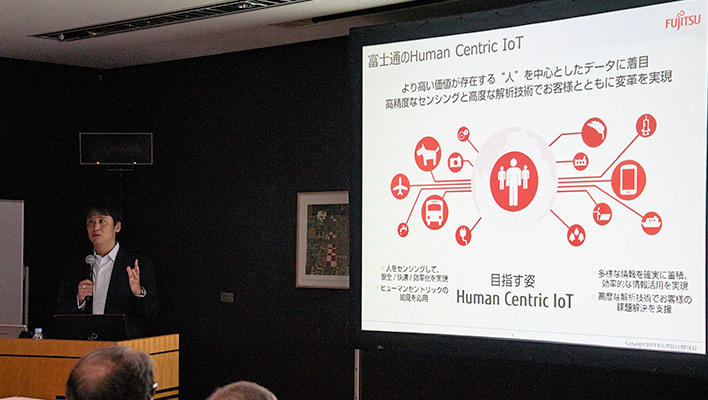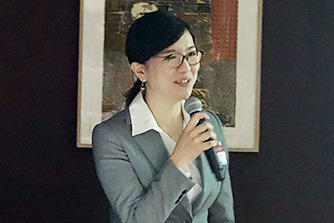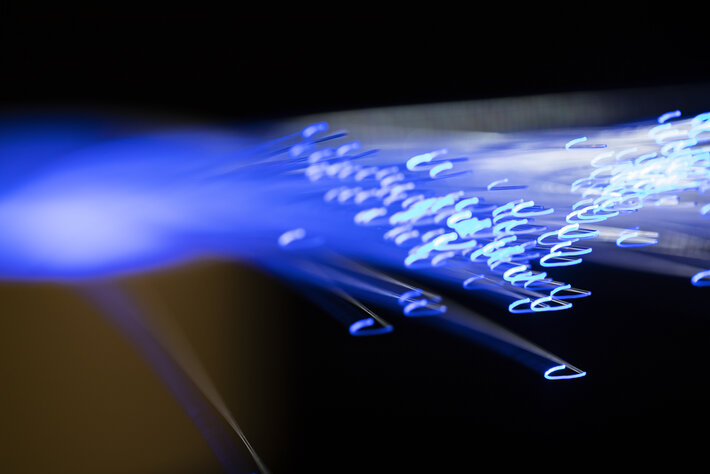Ensuring worksite safety is a never-ending task. Fujitsu offers an IoT solution that reduces the risk of industrial accidents and health hazards, reduces costs, and improves productivity. This article introduces our safety management support solution that enhances worksite safety and work efficiency, both of which are needed in various industrial fields including manufacturing, infrastructure development, and energy. Learn how it works through a case study of Daikin Industries’ fluorine chemistry plants.
IoT-based Solution to Ensure Safe Worksites

Innovative IoT Business Unit, IoT Business Development Div.,Japan Business Dept.
Fujitsu Limited
Fujitsu’s IoT solution differs from conventional IoT solutions that use data transmitted from sensors embedded in devices without processing. Employing a sensor analysis algorithm that Fujitsu developed based on its rich experience in the mobile phone industry, Fujitsu’s IoT solution analyzes collected data and provides it to customers in an easy-to-process form.
With this algorithm, customers can reduce the time and costs required to develop an algorithm in-house and to test its validity. Meanwhile, they can quickly and easily satisfy their needs for strengthening safety management and launching new services.
The key elements of the UBIQUITOUSWARE introduced in this article are the core module and sensor algorithm. The sensor algorithm analyzes measurement data provided by the various sensors in the core module and converts it into valuable data. Such conversion enables numerical expression and effective use of data on posture, falls or slips, heat stroke risk, and physical burden in order to build a safety or labor management framework.
Customers can embed the aforementioned core module into their products to create IoT devices. They can also use a Vital sensing band or location badge, which are hardware devices provided by Fujitsu, together with the core module. This safety management support solution provides an SaaS application for PCs and smartphones, making quick deployment possible.
A pilot pack is available for customers who wish to examine in advance what type of data they can use with the safety management support solution. Its design accommodates various purposes and customers can use it to check the solution’s data accuracy and compatibility with their management flow.

Industrial Accidents and Countermeasures at Daikin Industries
Examination of Simple, Effective IoT-based Safety Measures
“Daikin Industries has two chemical plants in Japan. These plants operate 24/7, and a total of approximately 400 workers manufacture fluorine chemical products there. Fluorine is used in various industries including automobiles, IT, construction, and solar power generation due to its water- and oil-repellent and heat- and chemical-resistant properties. These plants use explosive gases and dangerous chemicals, such as sulfuric acid and other various acids, and workplace temperatures can become very high. For this reason, taking measures to reduce industrial accidents is extremely important.

Production Innovation, Manufacturing Planning Department, Chemical Division
Daikin Industries
“While the number of deaths and injuries due to industrial accidents has been decreasing in Japan, more than 20,000 workers in the manufacturing field alone were injured on the job in 2015. Falls and slips accounted for 40% of such injuries. Cases of heat stroke, another type of industrial injury, have been increasing in frequency. This is because the ideal solution, which is to cool down outdoor or high temperature worksites, is infeasible. With the decline in workforce size, the number of worksites where a single person works alone has been increasing. At such worksites, there is the risk of delayed rescue if an emergency occurs. Therefore, it is important to take safety measures for those who work alone.
“To prevent industrial accidents, we provide safety education to give participants the opportunity to experience the potential dangers of machines and chemicals, such as getting caught in a rotary machine or being injured in an explosion. We also have daily safety measures; plant workers and their supervisors check each other’s physical conditions and understandings of work tasks by means of reports and discussions.
“Still, it is impossible to prevent all industrial accidents. One problem to address is that workers are responsible for judging their own physical conditions. Supervisors are not doctors. Workers may intentionally not report poor physical conditions because they are afraid of causing trouble for others or because they are too focused on work to realize that they are not feeling well.
“Despite taking many safety measures and introducing new rules, ensuring complete compliance at the plants has been challenging. Thus, we decided to use an IoT solution to help us realize effective safety measures.”
Introduction of the Safety Management Support Solution to Enhance Safety
“We wanted two features from an IoT solution: the ability to detect abnormalities in physical conditions without relying on human decisions, and the ability to analyze changes in physical conditions to identify high-stress work, which is one cause of heat stroke. Meanwhile, our IoT device requirements were the ability to operate without interfering with work and the ability to detect abnormalities even in high-temperature work environments, including outdoors and in hot rooms.
“We examined a few companies’ products and decided to test Fujitsu’s safety management support solution because it best matched our requirements.
“This safety management support solution offers three functions: health management, safety management, and labor management. In our case, health management and safety management were important. We tested the solution under our most severe work environment: working alone in three eight-hour shifts while outdoors or inside a room with a high heat source. This test focused on heat stroke prevention effectiveness, fall and slip detection, and data analysis to improve work.
“We at Daikin Industries met with Fujitsu many times during the test period to adjust the product specifications to support our chemical plants’ environment. One adjustment was the alarm feature. The safety management support solution can set off two types of alarms based on workers’ physical conditions: heat stress alarms and physical burden alarms. Early in the test period, these two alarms were activated 13 times in total per day. Only three functioned correctly; the others sounded when workers were exposed to low physical stress or while on break or doing desk work.
“This was due to Fujitsu’s design concept, which placed importance on activating alarms early to avoid danger. We therefore adjusted the alarm criteria to match our work environment. As a result, alarms were sounded at the correct timing — one worker even commented: ‘The alarm sounded when I was completely focused on my work. I took a break because of the alarm, but I may have started to feel sick if I continued to work just 10 minutes longer.’
“Another improvement was the Vital sensing band, which is a sensing device that works with the safety management support solution. While correct sensing requires the sensor to be in full contact with the skin, the band’s initial version was difficult to wear correctly and required time to put on. We worked with Fujitsu to improve the band so that it can be worn easily and stay in contact with the skin.”

Smartphone Linkage to Check Workers’ Physical Condition Data
The number of false positives dramatically decreased after improving the alarm and band. Still, two problems remained. When a worker wore rubber gloves, an alarm was sometimes activated erroneously because the band identified a work environment problem due to the raised temperature and humidity inside the gloves.
“When a worker swung his or her arm widely, a false positive also occurred due to erroneous identification of a fall or slip. We suspected that wearing the sensor band on the upper arm may solve these two problems. Our test indicated that measurement data when the sensor was worn on the upper arm was close to that obtained when the sensor was worn on the wrist, and the frequency of false positives for fall/slip detection decreased because the arm was closer to the chest.
“Workers welcomed wearing the sensor on the upper arm. By doing so, their rubber gloves did not affect sensor performance, so they could put on the gloves smoothly without worrying about them getting stuck on the band, and they could focus on their work with fewer false alarms. We provided this test result to Fujitsu, which is considering commercialization of an upper arm sensor.
“Many supervisors wanted to see workers’ physical condition data on their smartphones. Although they can access all this information on a PC, they are not necessarily always in front of a computer. Therefore, Daikin Industries is now working with Fujitsu to develop a smartphone app that enables users to see a list of workers’ physical conditions and work situations.
“The safety management support solution indicates the level of physical burden felt by workers as an objective numerical value. Our analysis results have shown that the same amount of work imposed less of a physical burden on workers in their 20s than workers in their 40s. Also, the same amount of work resulted in different levels of physical burden between heavier and thinner workers. By switching from the current equal work volume distribution to an equal workload distribution, we believe we can avoid having workloads become concentrated on specific individuals, thereby reducing the risk of health problems.
“In this way, we gathered input from workers and improved the system through frequent meetings with Fujitsu during the test period. Now that we have a system that generally meets our initial request, we will commence practical use in June 2017.”
Locating Workers
“Initially, we chose the safety management support solution in order to prevent industrial accidents. Now, we plan to add some features to the solution to enhance productivity. One feature is a worker locating feature to reduce the number of human errors. A worker wears a location badge on his or her chest during work. The supervisor monitors the worker’s location and whether or not work is done in accordance with the specified procedure. If the procedure is not followed properly, the supervisor will be notified by an alarm. Although we are currently checking worker behavior manually, we are considering systematization in the future.
“Another feature is to use smartphones to reduce the necessity for workers to prepare handwritten records and to promote information sharing. During the test period, we used Fujitsu Smart Communication to enable workers to share photos of finished work via a chat program and to explain onsite situations via videoconferencing. Workers highly appraised this feature because it resembles the familiar messaging app LINE. We are considering the roles this feature can play in future system introductions.
“The introduction of IoT to Daikin Industries’ Chemical Division has just begun. While some issues remain to be addressed, we hope to continue working with Fujitsu to enhance the system’s value.”










